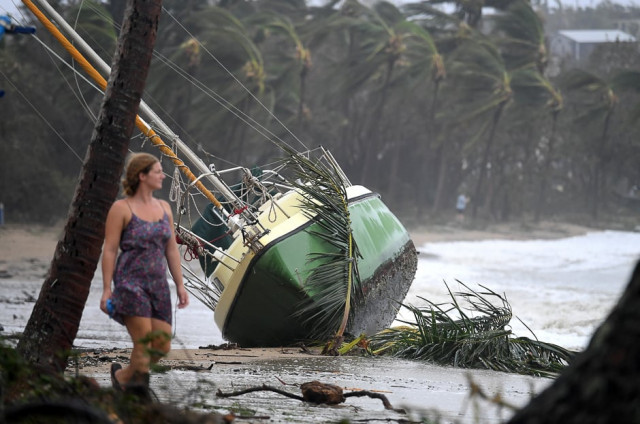Thousands evacuated in New Zealand amid Cyclone Debbie floods
Two days of heavy rainfall at the tail end of Cyclone Debbie led to landslides that blocked roads

A woman walks past a yacht that was washed ashore after Cyclone Debbie hit the northern Queensland town of Airlie Beach, located south of Townsville in Australia. PHOTO: REUTERS
The effects of the former category 4 storm, one level shy of the most powerful category 5, were also still being felt in Australia more than a week after the cyclone pounded Australia's Queensland state flooded towns.
Scores of roads were closed or blocked by landslides across New Zealand's North Island following two days of heavy rainfall caused by the tailwind of Cyclone Debbie. The storm killed six people in Australia, smashed tourist resorts, brought down power lines and shut coal mines.
No deaths have been reported in New Zealand, but authorities continued to search for a man reported missing in a swollen river.
Australia floodwaters still rising, police search for missing
"There's still a risk of loss of life," New Zealand Deputy Prime Minister Paula Bennett told reporters in Wellington as rescue workers raced to evacuate the town of Edgecumbe in the Bay of Plenty.
"Under no circumstances should people be looking at going back at the moment," she said. "The message must be really clear to people right now: Get out and stay out."
New Zealand's mountainous terrain makes its roads susceptible to landslides and many regions are still recovering from November's 7.8-magnitude quake.
Kaikoura, the coastal holiday town at the epicenter of that quake, was shut off from the rest of the country for the second time in six months as connecting roads were again hit by landslides.
In Australia, where the deluge was still flowing through tropical river systems, water levels peaked in the city of Rockhampton at lunchtime on Thursday, flooding main streets, shops and homes.
Fresh whale stranding on notorious New Zealand beach
Residents rowed boats along main roads and muddy water covered the airport's runway. Authorities said the airport will be closed for six days and the water is not expected to recede until the weekend.
The Australian disaster zone stretched 1,000 km from Queensland's tropical resort islands and Gold Coast tourist strip to the farmlands of New South Wales.
Australian insurers have declared the event a catastrophe likely to cost more than one billion dollars, with state officials saying recovery and repairs will take months.
"The flooding has been worse than we anticipated," Peter Harmer, the chief executive of Australia's largest insurer IAG said at a business conference in Sydney on Thursday. "The cyclone impact itself was less than anticipated."
Harmer said IAG was using drones to compile early assessments of the damage which he expected to total "in excess of A$1 billion."



















COMMENTS
Comments are moderated and generally will be posted if they are on-topic and not abusive.
For more information, please see our Comments FAQ